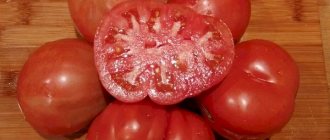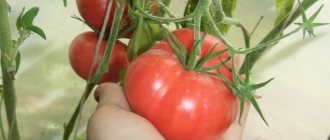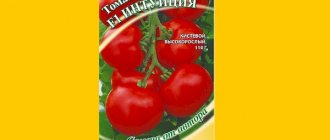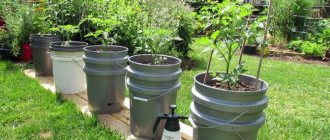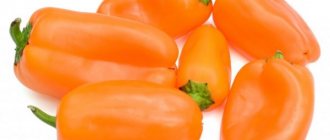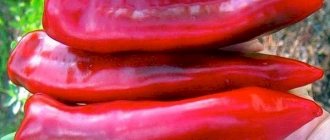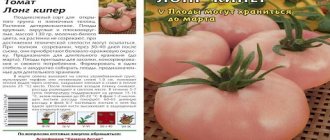Vegetable growing » Zucchini
0
663
Article rating
Kira Stoletova
Yasmin F1 zucchini was bred by Japanese farmers representing the well-known Sakata brand. This variety has a high yield and is quite unpretentious to weather conditions. The vegetable is grown both in greenhouses and on open land.
Varietal characteristics of zucchini Yasmin F1
Description
In Russia, this zucchini is extremely popular not only among producers and farmers of large agricultural firms, but also among the local population.
This species belongs to the zucchini subtype. It is a low shrub with branches collected in one place. Its leaves are small for its variety, so they compactly occupy the intended area. They are also slightly dissected and in some places covered with barely noticeable spots.
In addition, it is resistant to various diseases and infectious agents.
The fruits have the following characteristics:
- cylindrical shape;
- pronounced yellow tint;
- length up to 25 cm:
- weight of mature zucchini – up to 300 g;
- medium-sized seeds in the shape of an ellipse;
- The pulp is dense and cream-colored.
Description of the zucchini variety Yasmin F1
According to the description of the variety, Yasmin zucchini belongs to the hybrids, as indicated by the F1 symbols in its name, and belongs to the zucchini variety. The plant can bear fruit both in a separate area and among similar varieties. The main regions of distribution of the crop are the southern regions, central Russia, where seeds are sometimes sown in open ground in the spring, although most gardeners prefer to grow them in seedlings.
Advantages
The advantages of this variety include:
- compactness of the bushes, which in their own way do not spread their branches over a long distance: per 1 sq. m you can plant up to 5 zucchini bushes;
- all fruits grow synchronously. This allows you to harvest at the same time, without leaving some vegetables until later due to the fact that they did not have time to ripen;
- hybrids grow quickly - in 40 days. This property saves time and effort;
- Zucchini can be grown both in greenhouse conditions and in open ground, so farmers have a choice of where it is best to sow or plant the plant;
- the fruits contain a large amount of carotene.
The only drawback is the seeds, which according to their characteristics are not suitable for further planting and propagation of the plant. It is necessary to sow already treated seeds. You can buy them in specialized stores in packs of 5 pieces.
Pros and cons of the variety
| Advantages | Flaws |
| The variety is unpretentious in cultivation. | The plant is a hybrid, so the seeds must be purchased anew every year. |
| Characterized by long-term fruiting. | Does not grow well in the shade and does not like drafts. |
| High fruit uniformity. | Seeds are not cheap. |
| It is convenient to collect the fruits; they are clearly visible under the leaves rising upward. | |
| Zucchini is resistant to the dangerous viral diseases zucchini yellow mosaic and watermelon mosaic. | |
| The fruits contain a lot of carotene. |
Growing
The variety can be grown both in open ground and under film. In the second case, seedlings are used, which are obtained in a bright, warm place (in an apartment this can be a window sill or a loggia). This method is also suitable in cases where harvesting is planned in the middle of the summer season.
In northern Russia, it is better to grow zucchini in a greenhouse
The greenhouse is suitable for areas where summers are cool and sunny: these are the northern regions of Russia.
Preparatory stage
To properly grow fruits, it is necessary to carry out a set of measures before planting seeds:
- in the autumn, it is recommended to thoroughly loosen or dig up the soil layer to 20 cm in depth so that the soil is well saturated with oxygen;
- It is necessary to apply mineral fertilizers to increase the nutritional composition of the soil. For 1 sq. m of land, 5 kg of organic substances, superphosphate and potassium impurities in a volume of 30 g are added;
- With the arrival of spring, the area prepared for planting must be harrowed. This action will help stop the emergence of weeds and harmful crops;
- Immediately before planting the seeds, you need to loosen the soil again to 10 cm in depth and apply fertilizer. This time they use ammonium nitrate - about 15 g. In the event that no fertilizers were added in the fall, the soil is replenished with phosphorus and potassium in the amount in which it was necessary to add them during the autumn activities.
Landing
After carrying out a set of preparatory measures, sowing is carried out. As planting material, you can take either seeds or seedlings grown for 3 weeks in greenhouse conditions.
It is recommended to buy colored seeds, because... they are pre-treated with special products that will protect the adult bush from various diseases and pests.
If the seeds have already been processed, they do not need to be soaked before sowing. The soil must be heated by sunlight to at least 12 °C, otherwise the grains will not be able to germinate.
It is necessary to prepare the landing site in the form of holes in advance. These holes have their recommended dimensions: 40 cm in diameter and 10 cm in depth. Then apply humus fertilizers or settled mullein in the amount of 1 kg for each plant.
It is recommended to plant 1 sq. m no more than 3 plants, so that they can get a sufficient amount of useful elements from the soil, as well as occupy the necessary territory for their optimal growth. They can also be planted next to other squashes because cross pollination does not occur.
After all the activities, seeds or seedlings are planted and watered with warm, settled water. The process of mulching is also carried out - adding organic fertilizers (for example, composted products).
Thanks to organic matter, the plant has a sufficient amount of moisture throughout its development and is filled with nutrients. For better germination, add 100 g of wood ash and a pinch of mineral fertilizers to each hole.
Additional instructions
There are rules that, if followed, will help you grow high-quality zucchini:
- if the soil cover of the area prepared for growing vegetables has strong acidity, it must be reduced with lime or chalk components;
- In the early stages of planting seeds in open ground, a prerequisite is to cover them with darkened film material. During the day, it is opened slightly and the plant is allowed to spend time in the fresh air;
- The planting of seed material takes place from May to June. To do this, holes are made in the ground, which are located at a distance of 5 cm from each other and have a depth of up to 3 cm;
- 2-3 seeds are placed in each planting hole;
- After the seeds have sprouted, it is necessary to thin them out so that there are up to two sprouts left in one hole.
Characteristics of the variety
Zucchini is grown in many regions of Russia. It is ideal for greenhouses and open areas. The features of zucchini include the following:
- Compact bushes, low-slung and not spreading.
- Vegetables grow at the same time.
- Instant growth and formation of the bush.
- Equally suitable for cultivation in greenhouses and open areas.
- The fruits are yellow and cylindrical.
- High fertility.
- Early variety. The fruits ripen in 40 days, and the growing season ranges from May to September.
It is better to place no more than three bushes per m2 of land. The distance between bushes is 60 cm. The size of vegetables can reach 500 grams. Yasmin has many advantages over other varieties of zucchini.
The variety is resistant to many diseases, in particular to watermelon mosaic and zucchini yellow mosaic. This variety also contains a lot of carotene. The variety is characterized by high fertility and long fruiting time.
Care
Zucchini needs to be watered regularly
To get a good harvest at the end of the planting season, it is necessary to carry out a set of measures to care for the plant. A description of the steps for growing Yasmin F1 zucchini can be found on the back of the package in which the seeds were sold. These include:
- regular watering. Zucchini needs moisture constantly. After the seeds have been planted, the hole must be watered, since without a certain level of moisture the plant may not sprout and simply dry out in the ground hole. When the bush begins its flowering period, watering must be increased several times. For example, for 1 sq. m use approximately 2-3 10-liter buckets of water. It is recommended to carry out water procedures in the evening, when the heat subsides and the water warms up to the required temperature;
- application of fertilizers. After the first signs of zucchini germination appear on the surface of the earth, it is necessary to apply fertilizers that affect the growth of the fruit. Such procedures are carried out 1-2 times a week, depending on the nutritional composition of the soil. In this matter, nitrogen impurities and potassium salt will be the best helpers, because these are the main elements in the development and formation of the fruiting body. If they are not contained in sufficient quantity, then the upper part of the vegetable begins to dry out and curl. These impurities are replaced by organic matter, which is mullein;
- loosening. When a crust forms on the surface of the earth and the soil does not receive enough air, it is necessary to loosen it. This effect often occurs after watering plants in the evening.
Preparing the site for planting
Preparing the site for planting and fertilizing the soil for the Yasmin variety is very important. The preparation is as follows:
- They begin to prepare the soil in the fall. Dig the ground to a depth of 20 cm or plow it.
- Fertilizers are applied. For 1 sq.m. plot, add 5 kg of organic matter, superphosphate and potassium sulfate at a rate of 30 g.
- In spring, the soil is prepared for planting seeds. The land is being harrowed. The procedure stops the growth of weeds.
- Immediately before planting, the soil is loosened to a depth of 10 cm.
- Fertilizers are applied. For 1 sq.m. add 15 g of ammonium nitrate. Phosphorus and potassium are added during planting if mineral fertilizers were not used in the fall.
Disease Prevention
Any agricultural crop is subject to diseases and the negative effects of pests. To reduce the impact of these activities, preventative weed and pathogen control measures are recommended periodically.
The main potential enemies for this type of zucchini are cucumbers and pumpkins, because... there is a huge chance that their diseases will be transmitted to Yasmin, and a cross-pollination reaction is also possible.
Among the most common vegetable diseases are the following: mosaic, rot, powdery mildew and anthracnose. Feeding the root system and the above-ground part of the crop helps combat them. Disease vectors can be spider mites and aphids.
More often, white powdery spots appear on the leaves, which spread throughout the entire leaf blade and lead to its wilting. A solution of colloidal sulfur, which is periodically (once every 20 days) sprayed on the plant, helps to get rid of this disease.
As preventive measures that prevent the appearance of rot, you can use a solution of copper sulfate and water the bush only with warm water.
In the case where the plant could not be saved, it is recommended to burn it and treat the source of the disease with copper sulfate. Otherwise, the disease will spread to other bushes.
Answers to frequently asked questions
Question No. 1. Why are Yasmin zucchini fruits hard and not juicy?
Most likely, it's all a matter of watering. Insufficient watering affects the taste of zucchini. With sufficient moisture, the fruits grow juicy and soft.
Question No. 2. What soil is suitable for this type of zucchini?
The plant prefers neutral or slightly alkaline soil. On acidic soils the bush may die. Lime is used to alkalize the soil.
Question No. 3. How to plant Yasmin in a garden plot, sow seeds in the ground or grow seedlings?
Both methods are suitable. For the southern regions, when there is no threat of frost, the seeds are sown directly into the ground. In the middle zone, seeds are sown in the ground in May; seedlings are rarely grown.
Question No. 4. What conditions are suitable for Yasmin zucchini?
Let's look at the features of cultivation in the table.
| Characteristic | Norm |
| The soil | Fertile, with a neutral or alkaline reaction |
| Good predecessors | Cabbage, legumes, nightshades |
| Watering | Abundant |
| Lighting | Requires good lighting, grows in sunny areas |
| Optimal temperature for growth | 21-26 °C |
| Bad Precedence | Cucumber, pumpkin, zucchini |
Question No. 5. How to prepare crops for long-term storage?
To prevent the collected fruits from starting to rot after a short time, they adhere to a special technology for harvesting and caring for the bush. To ensure that the fruits are well preserved and do not rot, watering is stopped two weeks before harvest. Small fruits, flowers and ovaries are removed, leaving 2-3 fruits of the correct shape without signs of spoilage.
Since dew appears on the crop in the morning in August, the bushes are mulched to prevent rotting of the fruits. They put pine needles. The fruits do not touch the ground and are well preserved. For storage, do not pick young zucchini with delicate skin. They will rot quickly.
Harvest and storage
Fresh vegetables can be stored for a month
This variety of zucchini produces a good harvest, which can be harvested as early as mid-August. Vegetables can be stored in the basement for 4 weeks without their appearance or taste deteriorating.
It is advisable to remove fruits from the branches when they reach 25 cm in diameter, so that they do not become harder.
When harvesting, remove excess elements of the bush: ovaries and small fruits that have not acquired enough nutrients to acquire the correct shape and weight. You can leave 2-3 fruits on the bush that meet the specified characteristics.
Productivity per 1 sq. m can reach from 4 to 12 kg. It will depend on climatic conditions and crop care.
When the first ovaries appear, some gardeners pour coniferous residues under the bush itself, which will retain moisture and not touch the ground cover. This variety of zucchini can be preserved in jars for the winter or used for a regular diet.
Fertilizers and bait for zucchini
For good fruiting, at least three feedings are needed during the growing season. The first time they are fed before flowering begins. Use ammonium nitrate, superphosphate, potassium chloride, manure or chicken droppings. During the period of growth and development of the bush, Rossa fertilizer is suitable. 1 liter of the prepared solution is poured under the bush. To prepare the solution you will need 2 tbsp. l. fertilizers per 10 liters of water.
The second feeding occurs during the flowering period. The following composition is used for fertilizer:
- 2 tbsp. l. wood ash;
- 2 tbsp. l./per 10 l of water fertilizer "Effecton".
During the third feeding, add 2 tbsp. l. ash and 2 tbsp. l. "Effekton-O" fertilizers. The norm is increased, up to 2 liters of solution are poured under the bush. In addition to root feeding, foliar feeding is also carried out. Use “Bud” preparations or “Rossa” liquid fertilizer. To prepare the “Bud” solution, take 10 g of the product per 10 liters of water. We offer popular brands of fertilizers for zucchini in the table.
| Index | "Blank sheet" | "Hera" | "Agricola-5" | "Effecton" |
| Type of fertilizer | mineral | humatized organic-mineral | mineral | organic-mineral |
| Compound | nitrogen, phosphorus, potassium, sulfur, magnesium, boron, iron, manganese, zinc, copper and cobalt | nitrogen, phosphorus, potassium | sodium, phosphorus, potassium, magnesium and other trace elements | nitrogen, phosphorus, potassium |
| Application | foliar and root feeding | root dressings | foliar and root feeding | seed treatment, application to the soil before planting, foliar and root feeding |
| Deadlines | growing season | during planting and during the growing season | during fruiting every 10 days | during planting and during the growing season |
| Result | productivity increases, the plant is supplied with nutrients, taste characteristics improve | bush growth accelerates, productivity and disease resistance increases and | plant strengthening, disease resistance, good harvest | growth accelerates, stability increases, productivity increases |
[wp-svg-icons icon=”file-word” wrap=”i”] reviews from gardeners about Agricola fertilizer
Errors during cultivation
The main mistakes that gardeners make in this case are:
- lack of shelter for the plant - in the case when seedlings are grown in April, it is necessary to use film material to avoid temperature changes in the environment and possible morning frosts;
- cracks on the fruits - if ripe zucchini is not picked in time, they begin to crack, so it is recommended to pick them when they grow 20 cm in length;
- the hole is the wrong size - for the seeds to germinate, it must be no more than 5 cm deep, otherwise they will rot;
- choosing shady areas for planting - it is worth paying attention to the fact that Yasmin zucchini loves illuminated places and will not be able to ripen without sufficient sunlight.
According to reviews left by experienced gardeners, the variety has high yields and is a win-win option for home preparations for the winter. Throughout the entire storage period, the vegetable retains its density and juiciness. Its taste is also distinguished.
Additional rules
There are some rules, if followed, you can get high-quality zucchini:
- If the soil of the area created for the cultivation of zucchini has high acidity, it must be reduced with the help of lime or chalk substances.
- In the early stages of sowing seeds in open ground, be sure to cover them with dark film material. During the day, you need to open it slightly and let the plant ventilate.
- Sowing of seed material is carried out in May to June. To do this, holes are made in the ground, which are located at a distance of 5 cm from each other and up to 3 cm deep.
- You need to put 3 seeds in each planting hole.
- After the seeds germinate, you need to thin them out so that there are up to two sprouts in one hole.



